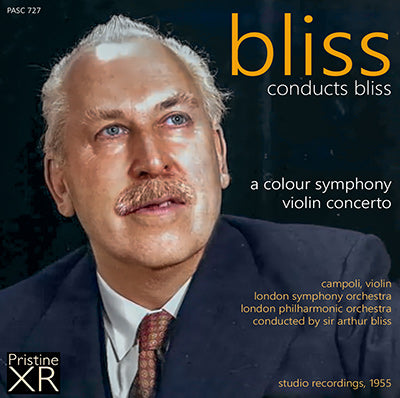
- Producer's Note
- Full Track Listing
- Cover Art
The main work … on this disc is the Concerto, commissioned by the B.B.C. and first played at the Royal Festival Hall in May of last year with Campoli (to whom it is dedicated) as soloist. The performance here is a fine one, and Decca have produced for it one of their very best recordings, of great clarity but warm tone. The concerto itself is as yet too little known for the musical world to have been able to assess its stature, and this recording will therefore be of all the greater value. Personally, I find the work among Bliss’s most effective, full of energy and nervous tension, in the composer’s most mordant vein, also with considerable lyricism, and certainly brilliantly written for the soloist. Is it, perhaps, a little long for its material in the first movement? The Scherzo is pithy, and the finale unusual in structure, consisting of a slow introduction leading to an Allegro deciso in gipsy style. I look forward to becoming more familiar with this concerto through this admirable recording.
Lionel Salter, The Gramophone, June 1956
The Colour Symphony was [Bliss’s] first large-scale orchestral work, and was written for the Three Choirs Festival in Gloucester in 1922: with poetic justice, the orchestra chosen to record it now is that which gave the first performance on that occasion (are there, I wonder, any of the early players till with it?). In the original score the movements bore, beside the designations Purple, Red, Blue and Green, sub-titles relating these colours to their heraldic significance (“ Purple, the colour of amethysts, pageantry, royalty and death ”, etc.); but when Bliss revised the symphony ten years later, he cut out this “programme” so that the music should be listened to on its own terms. Heard to-day, in this full-blooded performance under the composer, one is conscious of his disciplined exuberance at thirty years old, and of the distance he has travelled since: there are moments nevertheless — the dissonant syncopated passage in Red, the “optimistic” second fugue in Green— which point forward to his fully mature style.
To-day he would probably thin out the scoring (though I hope he would leave the exciting six-timpani flourishes near the end): indeed, the tendency towards a more clean-cut texture is already seen in the other work recorded here, the Introduction and Allegro dedicated to Stokowski (who conducted the first performance in 1927 in Philadelphia) … The composer secures a convincing performance from the L.S.O., and the recording is perfectly good, if not quite in the same class as that of the Violin Concerto.
Lionel Salter, The Gramophone, August 1956
Looking back some 69 years to the month of November 1955, when these two recordings were made, it is hard to understand how Bliss came to conduct two different orchestras in his own works in the same month – for the same record company and at the same venue. It is something which has clearly confused Decca in some of its later reissues, where artwork and texts have been both confused and, at times, incorrect!
Both were produced and engineered by Decca’s crack team of John Culshaw and Kenneth Wilkinson, and the sound quality of the mono originals is excellent for its day, even if better things were just around the corner for the London-based label. These XR-remastered Ambient Stereo issues have dusted them down a little, bring greater space and finer tone to both recordings, further enhancing two excellent examples of Decca’s mid-fifties output.
BLISS conducts Bliss
BLISS Concerto for Violin and Orchestra, F.111 (1955)
1. 1st mvt. - Allegro ma non troppo - Più animato (14:26)
2. 2nd mvt. - Vivo - Tranquillo (6:49)
3. 3rd mvt. - Introduzione. Andante sostenuto - Allegro deciso in modo zingaro (16:31)
Campoli, violin
London Philharmonic Orchestra
Recorded 9-11 November, 1955
BLISS A Colour Symphony, F.106 (1921-22,rev.1932)
4. 1st mvt. - Purple (6:39)
5. 2nd mvt. - Red (6:54)
6. 3rd mvt. - Blue (9:54)
7. 4th mvt. - Green (7:49)
London Symphony Orchestra
Recorded 23-24 November, 1955
conducted by Sir Arthur Bliss
XR remastering by:
Cover artwork based on a photograph of Bliss
Recorded at Kingsway Hall, London
Total duration: 69:02

